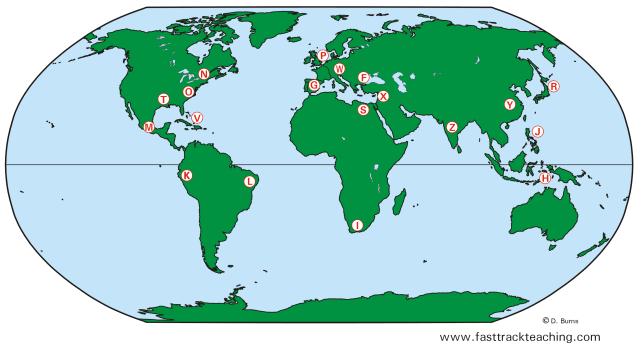| Section 1: Discovery and
Exploration
Practice Test 1
Write your answer choices on a piece of paper, then
click on the "Answer Key" button at the end to check and grade your
test. 1. Most experts think that the Native Americans (Indians) first arrived in North America 10 to 40 thousand years ago by A. rowing primitive boats across the Atlantic Ocean from Northern Europe.B. sailing canoes across the Pacific Ocean from Hawaii or nearby islands. C. traveling from northern Asia across to what is now Alaska. D. sailing rafts from Western Africa to Central America. 2. Which of these is the best explanation for the "rebirth" or Renaissance of European civilization around 1300 - 1400 A.D.? A. the discovery of the New World and its wealth,
especially gold, that came to Spain 3. Which of the features below was NOT generally associated with the Renaissance? A. the idea that the world can be understood,
especially with science and mathematics 4. Why did Spain and Portugal take an early lead in the Age of Discovery? A. They were both Catholic countries. 5. On his first voyage of discovery, Christopher Columbus was trying to find A. a sea route by which ships could sail to the
lands of the Far East. 6. When did Columbus make his first voyage to the New World? A. 1420 7. Which is NOT a true statement about the geographic and navigational knowledge of Columbus as he set out on his first voyage of discovery? A. He thought the earth was smaller than it really
is. 8. Which explorer below sailed for England and helped establish an early English claim on lands in North America? A. Hernando de Soto 9. Where does the name "America" come from? A. It is Latin for "New World." 10. How did the system of land ownership of Native Americans compare to that of Europeans? A. Indians life was built around a system of
individual ownership of land, much like that of Europeans. 11. Which Native American group lived in what is now the Southwestern United States? A. Inca 12. Which of these is NOT true of the Aztec Indians? A. Their religion opposed all forms of bloodshed. 13. Which of these is a true statement about smallpox? A. It was a disease carried from Europe that wiped
out millions of Native Americans. 14. Which of these best describes the reason or reasons why the Spanish explored and conquered large areas of Central and South America? A. They mainly wanted the land, because Spain did
not have enough. 15. Which is an example of the Columbian Exchange? A. the division of South America between Portugal
and Spain 16. By considering the life of Bartolome de Las Casas, which issue below would he most likely want to get involved in if he were alive today? A. How can we make better space ships for the
exploration of Mars? 17. What and where was “The Lost Colony”? A. a sugar growing colony planted by Portugal on
an island near Africa 18. The purpose of missions built in the New World by the Spanish was A. to provide military protection for Spanish
settlers. 19. Which of these best describes the houses of the Indians first encountered by the English explorers in the coastal areas near the Chesapeake Bay? A. They were built of stone. 20. Which of these was NOT a result of the meeting of the Old World and the New World in the early 1500s? A. Many Native Americans died of European diseases
and exploitation. Use the map below to answer questions 21 to 30.
22. Which letter shows the location of the Spice
Islands, known today as the Molucca Islands? 23. Which letter shows the location of India, which
was
reached by the Portuguese explorer Vasco da Gama? 24. Which letter shows the location of Spain, the
country that sponsored Columbus and Magellan on their famous voyages of
discovery? 25. Which letter shows the area where Columbus
landed on his first voyage to the New World? 26. Which letter shows where the Aztec Empire was
located? 27. Which letter shows where the Inca civilization
was located? 28. Which letter shows the area that French
explorer Jacques Cartier searched unsuccessfully for a "Northwest
Passage" in 1534? 29. Which letter shows the location of England? 30. Which letter shows where the English put the
settlement known as "The Lost Colony"?
|
